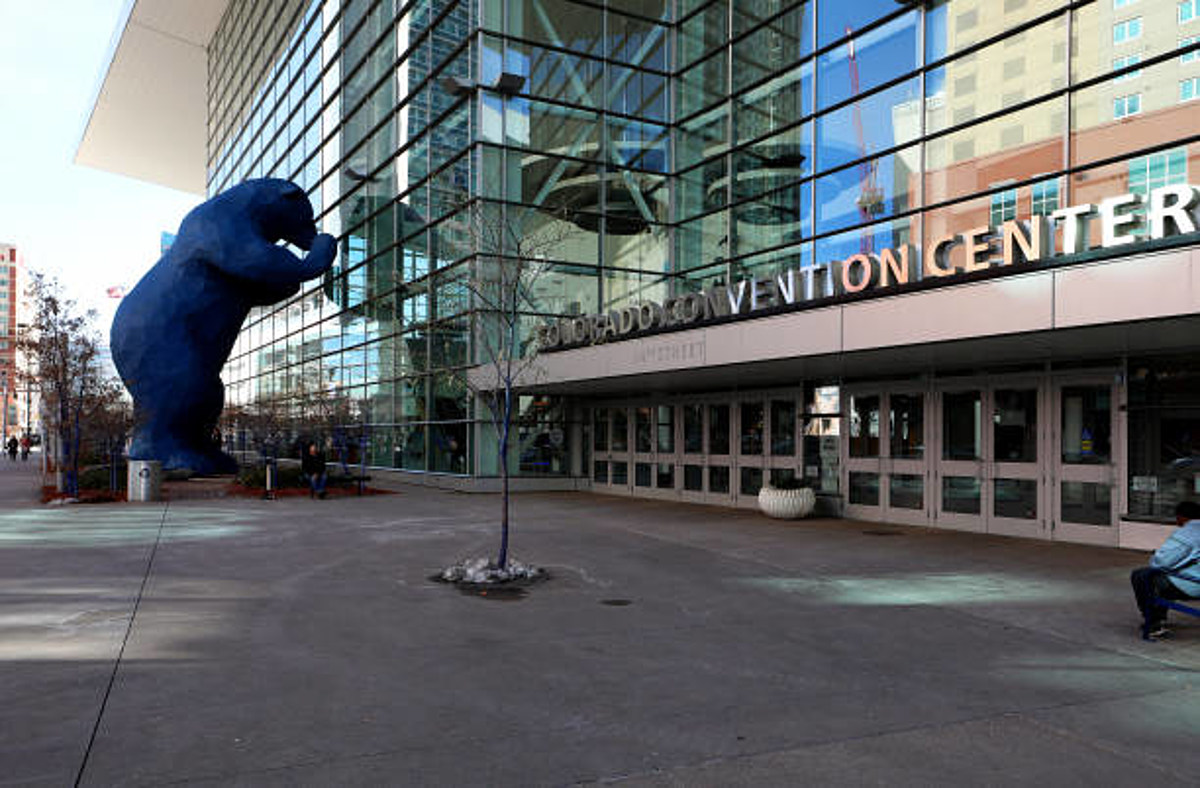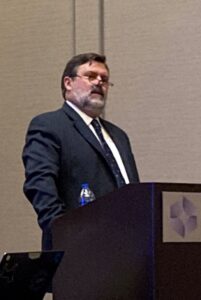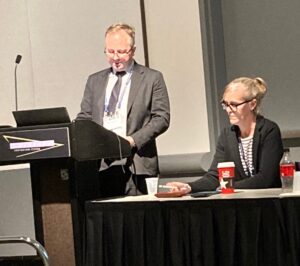2022 SBL Diary: Part One
Back in the pre-pandemic era, I would follow up my trip to the SBL Annual Meeting with a series of posts on the highlights of the sessions, receptions, and other activities (beginning in 2014 and including the last time SBL was at Denver in 2018). When the meeting went virtual and then hybrid, there wasn’t much to be said, though I did post my entire paper from last year’s online session (HERE). But it’s a new year and SBL was fully in-person this time (except for the occasional pre-recorded paper), so I stifled all of the anxiety that has been building in me over the past two years and headed off to Denver. Things did not start well. Reduced traveling seems to have had an effect on my trip-planning abilities and I inadvertently booked my flight under the name Tony instead of Anthony, the name on my passport. Thankfully I caught the error the day before my journey and a friendly guy at Expedia helped me fix the problem—though it did mean I had to cancel one flight and rebook (at an extra $300). Thanks Air Canada. Even the next day I was still uncertain that everything had been changed correctly. I knew I’d be able to get to Denver, I just didn’t know if I’d be able to get back.

Day 1 started by packing up my car with local SBLers and heading to the airport. Since I volunteered to drive, my wife advised me to get the car cleaned. The folks at the car spa knew a sucker when they saw one and upsold me to the “silver” package that included upholstery cleaning. We were going to get there in style. But maybe a little damp. The seats were sopping wet even a day after the cleaning. Sigh. So much for being classy. Fortunately, the flight went without incident and on arrival, I checked into the hotel (Hotel Magnolia, which was close to the conference centre but seemed to be free of conference-goers) and met my apocrypal Jacob Lollar and his friend Blake Jurgens for a late dinner and drinks.
Day 2 was intended to be a largely free day because there were no scheduled Christian Apocrypha Section sessions. My wife asked me to pick up an order for her from the Loft—one of her favorite clothing stores, which shut down its Canadian operations during the pandemic. The location was a short bus ride away. I was pretty confident that I knew how to get there and back without incident but didn’t know how much it would cost or how to pay for tickets. Surely the hotel would have the answers. However, the young woman at the front desk told me with a nervous giggle, “I really don’t know but, like, I’m sure it’s less than $10.” Clearly this woman had never taken a bus in her life.
A few hours later, shopping trip completed I went off to the meeting to grab a lanyard and take in the book display. But before I could look at anything I needed food and a tea—stat. As usual the conference centre was not well-serviced but I managed to grab a sandwich and apocrypal Janet Spittler let me jump in with her in the long line at the lone coffee counter. Accompanying her were Stephanie Hallinger and Charlotte Von-Schelling, two staff members of the Beyond Canon Project situated in Regensburg. I was hoping to spend my next sabbatical with the project, so this was a good opportunity for me to ask questions about housing arrangements and timelines, etc. and basically get on the good sides of the people who really wielded the power. Soon I felt the book exhibit calling and made the first of several circuits around the hall. It was disappointing to see that so many of the presses did not bring sales stock this year (yes, you can order at a discount, but not all of the presses do free shipping outside of the US). Nevertheless, I was able to pick up some titles on the top of my list. My next activity was a scheduled meeting with Carson Bay, who contributed a translation of the Passion of Peter and Paul to MNTA 3. Aside from a quick hello at an airport a few years ago, we had never really had a chance to chat. And what is SBL really for but for socializing? Okay, there’s the papers, but really the true value is the relationships you start and the friendships and collaborations you cultivate.

And I did go to ONE paper! Stephen Shoemaker (University of Oregon) spoke on the genre of the Qur’an in the Corpus Hellenisticum Novi Testamenti Section (“A New Arabic Biblical Apocryphon: The Qur’an”). Shoemaker described the text as a “late antique hodge-podge” or a “religious miscellany” that defies easy classification. But he sees it as fitting the expanded definition of Christian apocrypha advocated by Eric Junod and now fairly standard in the field. He compared the text also to the Book of Mormon, often characterized as an American apocryphon; so the Qur’an would be an Arabian apocryphon, recasting biblical narratives to reflect the region’s particular experiences and interests. In a response to an audience question, Shoemaker remarked that he is more interested in what this classification says about canon in late antiquity (i.e., the authors’ approach to biblical and nonbiblical texts) than what it says about the Qur’an (and I agree; that IS interesting). Shoemaker’s description of the Qur’an as a “hodge-podge” reminded me of the Book of the Rolls, which also features a variety of genres, including some rewritten Bible, stories cobbled together from other apocrypha, new tales, and church canons. It too was composed in Arabic and was known to Muslim writers. I wonder if they would have found the style of the text familiar. I stayed for one more paper in the session and then considered my work done for the day.
In the evening I joined a bunch of fellow University of Toronto grads for our traditional SBL dinner and then headed over to the Woods Boss Brewing Company for a reception hosted by the Beyond Canon project. The beer flowed freely (but not the wine, alas) and I got to chat with a number of friends and colleagues, including Eric Vanden Eykel, Lorne Zelyck, and Lily Vuong. I also had a brief chat with Tobias Nicklas, the project leader, who confirmed that my residency at Regensburg was a go (see: you just have to talk to the right people). Hooray!

Day two began with a hearty hotel breakfast. I overheard the waiter say that they were down a cook so I checked to see if I would be able to eat relatively quickly. He snidely responded with, “Why, you got a bus to catch?” That’s 7:30 am on a Sunday in the service industry for you. Breakfast consumed, I headed off to the first apocrypha session. Thomas J. Kraus (Universität Zürich) began the session with “‘The Resurrection of the Flesh’ and What the Apocalypse of Paul Has to Say about It.” The paper struck me as the beginning of an investigation more than a presentation of results. Several texts were mentioned as comperanda, including the Epistle of the Apostles and 3 Corinthians. In the question period, Jens Schröter suggested adding to these the Letter of Rheginus (aka the Treatise on the Resurrection) and the Gospel of Philip. Most alarming about Schröter’s statement, however, was that he dropped in my name mid-sentence. Still half asleep, all I heard was “. . . Letter of Rheginus . . . I don’t know what you think, Tony . . .” My eyes widened in panic and a few people nearby giggled. Thankfully, the discussion never came back to me. The session continued with Rikki Wenxin Liu (Yale Divinity School) and “The First and the Last: Scholarly and Popular Reception of The Thunder, Perfect Mind.” Liu noted that there is much mystery about the origins of Thunder and that modern applications and interpretations of the text are as much likely to elucidate its contents as any ancient comperanda. She focused her discussion on the use of the text in Toni Morrison’s novels Jazz and Paradise, and Julie Dash’s 1991 film Daughters of the Dust. After the paper, John Marshall (University of Toronto) mentioned that Morrison and Elain Pagels were both at Princeton around the same time and likely Morrison’s interest in the text was sparked by that interaction.

Michael Zeddies followed Liu with his latest work on the Secret Gospel of Mark: “More Misunderstandings about Mar Saba 65.” He began with a discussion of the “naked man with naked man” portion of the letter and how it is often interpreted as a statement about homosexual activities by the Carpocratians. He noted that such terminology in other ancient sources refers sometimes to heterosexual acts (and the Carpocratians were known in other sources for their heterosexual license) and other times it serves as a metaphor for spiritual development. Zeddies’ other topic was the apparent rarity of an important ancient text being copied into the end papers of a European book. He mentioned an example of excerpts from an ancient text being copied into the marginalia of a printed book, but Gregory Givens remarked in the question period that the important thing is to discover whether the practice of adding any text to the end papers of a book is common. Smith did mention other examples in the Mar Saba library but nobody, it seems, has checked on those. Brent Landau’s and Geoffrey Smith’s forthcoming book on Secret Mark was mentioned also by an audience member, but Zeddies knew little about the book’s argument. I found out later in the day that proofs for the book were at the Yale University Press booth, so I passed that information on to Zeddies (and posted it to Twitter for other attendees). The final paper in the session was given by Cristian Cardozo (Universidad Adventista del Plata): “What Is a Name? Author-Function in the 1 Apocryphal Apocalypse of John.” It is good to see texts from MNTA getting some attention; at the same time as Cardozo spoke, Carl Johan Berglund was presenting a paper on another MNTA text, the Acts of Thomas and His Wonderworking Skin (“The Ascetic Subculture of the Acts of Thomas and His Wonderworking Skin”), but most of the people interested in that paper were in my room (thanks SBL). Cardozo’s paper focused on 1 Apocr. Apoc. John’s developments of ideas found in the canonical book of Revelation. Janet Spittler (University of Virginia) raised the point that interest in Revelation by the author of 1 Apocr. Apoc. John seems peculiar given the resistance to the canonization of Revelation in the Greek East. Jacob Lollar noted also that several other Greek apocalypses were composed around the same time, such as the Apocalypse of Pseudo-Methodius.
My next scheduled event was a meeting with my editor at Yale University Press, Abbie Storch. I am under contract to write an introduction to Christian apocrypha for the Anchor Yale Bible Reference Library. I signed the contract back in 2017 and projected that I should be able to knock it out in a couple of years. Well, five years later I’m only about one quarter in. I was prepared to give a sheepish confession and receive a thorough talking-to, but I am not Abbie’s first, nor worst truant writer and she was actually pleased by my progress. The goal now will be to finish by the end of my sabbatical in 2024/2025. So that means my time in Regensburg will be spent doing less traveling and more writing.

The final session of the day was a joint effort by Christian Apocrypha and Nag Hammadi and Gnosticism. It was an invited panel organized by Hugo Lundhaug, the co-ordinator of the APOCRYPHA research project at the University of Oslo (details HERE). Lundhaug started the session with an overview of the project and the various ways that the texts are being categorized and cataloged, including a database of names, practices, etc. as well as manuscript features such as materials and colophons. If I heard correctly, Lundhaug said that there are 233 works covered in the project and that more than 20% of known Coptic literature is apocryphal texts. I wonder if and how the results of their work will be made available to scholars (certainly there will be publications but it would be great if their database was made open access). The remaining papers in the session were presented by post-doctoral scholars who work for the project. First up was Roxanne Bélanger Sarrazin with “‘Eloi Eloi Lema Sabachtani’: Crucifixion Narratives in Coptic Apocrypha and Magic.” She discussed a prayer of Jesus from the Cross that is found in a Coptic “magical” text. The prayer begins with a harmony of material from the Passion narratives, mostly from Matthew. Then follows a monologue by Jesus describing his descent to hell and his encounter with a unicorn. By making connections with the Acts of Andrew and Paul (which will appear in MNTA 3), Bélanger Sarrazin explained that the unicorn is likely an image for the devil. The text concludes with ritual instructions for using the prayer as a charm against unclean spirits and demons. The prayer is an excellent example of the interplay of apocrypha and magic. Also of interest in this regard is the Encomium on the Archangel Michael by Pseudo-Timothy Aelurus which includes instructions for the use of Michael’s name as a defense against evil. If you want to learn more about this prayer from the cross, Bélanger Sarrazin has agreed to compile an e-Clavis entry on the text.
Florian Graz spoke next on “Frame-Narratives in Coptic Apocrypha.” These texts, sometimes called Pseudo-apostolic Memoirs, have become well-known through the work of Alin Suciu, who includes in the genre memoirs both with and without framing homilies attributed to the likes of Cyril of Alexandria. Graz focused only on the texts with frame narratives (called the A2 type in the database), which constitute fourteen works in all. Four of these state that the text was found in the House of Mary in Jerusalem (others have them discovered in an unspecified library in the city). Graz mentioned in his discussion the Monastery of St. Mark in Jerusalem (more information HERE) which is said to be built over site of the House of Mary, and that this monastery originally belonged to the Coptic church. He speculated that there may be a connection between the monastery and the composition of the frame narrative texts.
Samuel Cook presented an overview of “Apocrypha in the Monastery of Saint Macarius: A Study in the Materiality of Manuscripts.” This collection was described extensively by Hugh G, Evelyn White in 1926 (see HERE) but, Cook says, his assessment of the materials needs revision. The collection includes 35 separate apocryphal works, the most notable for our interests is an important manuscript of apocryphal acts in Bohairic. The final paper of the session was Lasse Løvlund Toft’s “The Creation of Man in the Copto-Arabic Literature: Canonical and Apocryphal Strains until the Thirteenth Century.” Toft divided the texts on the creation of humans into two forms: those in which the first man is made from clay fetched by angels (e.g., the Investiture of Abbaton), and those in which he is formed from the four elements (Encomium on Mary Magdalene). Both types of narrative are found also in Arabic texts (including, again, the Book of the Rolls) and these seem to have influenced Islamic thought. Overall the session was extremely well organized with excellent papers examining detailed aspects of the texts and their sources. There is clearly much in the Coptic apocrypha that remains to be studied.
I finished the day with dinner with Janet Spittler and despite having many options for receptions to crash, I opted to just go quietly back to my room. Reception hopping, with its attendant open bars, are not the attraction they used to be. My diary from the last time SBL was in Denver is certainly more exciting, including an account of my first encounter with edibles. In a semi-post-pandemic world, socializing takes more of a toll.
NEXT: I go on pilgrimage to Denver’s most important holy site.
